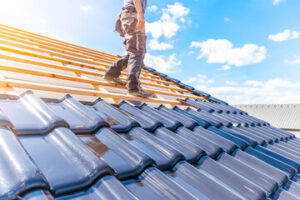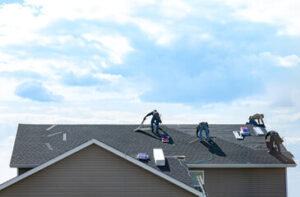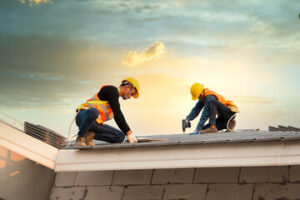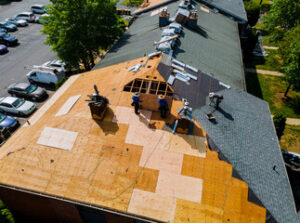A roof repair is more than just a house project; it is an investment in the value, efficiency, and longevity of your home.
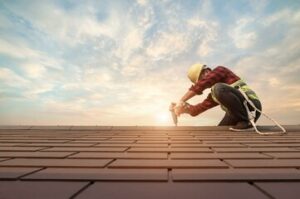
Cosmetic damage, a small leak, and other minor issues can be repaired quickly without requiring the cost of building a new roof. However, a sagging roof or excessive granule loss indicate more extensive problems that need immediate attention. Visit their Website to learn more.
When a shingle or tile becomes damaged, it is crucial to address the issue promptly. Not only will a damaged roof look unsightly, but it can also lead to leaks and other problems. A professional Naples roofing repair company can fix a broken shingle or tile and restore your home’s beauty and integrity.
Damaged shingles and tiles are easy to spot on a visual inspection. They can be identified by granule loss, which is a sign that the asphalt layer of the shingle is beginning to degrade. The granules help to shed water and protect against the sun’s damaging UV rays.
Shingles that are loose or missing can be replaced with roofing cement and new shingles. Before attempting any roof repairs, it is important to gather the proper materials and safety equipment. A ladder, a flat pry bar, a hammer and some roofing cement are all essential tools for repairing a roof. In addition, it is a good idea to wear sturdy shoes and a safety harness for added protection. It is also recommended to work on a warm, dry afternoon, as shingles are more supple in these conditions and less likely to crack or break.
Depending on the extent of the damage, you may only need to replace a single shingle. To do this, assemble the flat pry bar beneath the shingle directly above the one that is damaged and gently lift it. This will release the sealer strip and expose the first row of nails. Remove the nails with a hammer claw and pull up the damaged shingle. Place the replacement shingle in its place and nail it down using the new nails. Use additional roofing cement to reinforce the joint and cover any exposed nails.
If you have noticed a small area of missing shingles, it is possible that your homeowner’s insurance will cover the cost of a replacement. It is important to check with your insurance agent, as there are a number of variables involved. If the damaged shingle is not covered, you can apply roof tar to the affected area to temporarily patch it up. This solution is a quick and affordable way to temporarily repair a small hole in your roof.
Leaks
A leaking roof can cause serious interior damage, and it’s important to address the problem promptly. Neglected leaks tend to escalate, and can lead to extensive and costly damage that requires a full roof replacement.
The first step in repairing a leaking roof is to inspect the area and identify the source of the leak. Start by looking for water stains on the ceiling or walls. Once you’ve found the stain, follow it upwards to find where the water is dripping from. If you can’t spot the leak, look for areas where flashing has been used, such as around chimneys, vent pipes, skylights, and dormer windows. Flashing is made of a thin strip that keeps water out at vulnerable points, such as joints. Over time, flashing can become loose or damaged due to wear and tear or severe storms. If the flashing is loose but still in good condition, you may be able to repair it by using roofing nails or screws and applying a new bead of caulk or sealant.
If the flashing is damaged, you’ll need to replace it with new material. You can do this by removing the old flashing and scraping off any remaining adhesive or residue. Then, cut a piece of new flashing to size and apply it around the feature. After that, apply a bead of high-quality roof sealant and smooth it over the edges to ensure it’s completely watertight.
Leaks can also occur around roof vents, which are often installed with rubber boots that can crack or dry out over time. If you have a leaking roof vent, you can usually fix it by removing the existing boot and replacing it with a new one. If the existing vent is in good shape, you can use a waterproof sealant such as silicone to prevent leaks.
If you aren’t comfortable going onto your roof to make repairs, or your leak is widespread or causing significant interior damage, contact a professional roofing contractor right away. It’s also a good idea to have regular inspections of your roof to keep minor problems from escalating into major ones.
Sagging
A sagging roof can signal a wide variety of issues that could compromise the safety and stability of your home. It’s important to recognize these signs and address them as soon as possible, before they worsen and cause structural damage or a collapsed roof.
A number of different factors can contribute to a sagging roof, including improper installation or excessive weight on the roof. The best way to identify and address these issues is to hire a professional roofing contractor to perform a thorough inspection of your roof and its structure. They can assess the extent of the sagging, identify potential problems and recommend appropriate solutions.
Over time, roofing materials degrade due to constant exposure to the elements. Asphalt shingles may lose their protective granules and become vulnerable to water infiltration, while wooden beams or trusses can dry out and rot, affecting their ability to support the weight of your home. In addition, age can also play a role in roof sagging, as many older homes’ roofs are approaching the end of their lifespans and may begin to show signs of aging.
When left unchecked, sagging can lead to serious and expensive structural damage to your home. This can include drywall cracks and buckling, door and window jamming, or even foundation settlement. By addressing sagging early and taking the proper steps to prevent future problems, you can ensure your home’s structural integrity for years to come.
It’s important to note that while some sagging is normal, any sagging beyond a few inches should be addressed immediately. This is because sagging in the roof trusses or ridge can indicate that your roof frame is no longer capable of supporting the weight of your home, and this can be dangerous for your family’s safety.
If your home has a truss-style roof frame, sagging can often be repaired by replacing the old rafters with stronger, more durable materials. In more severe cases, the entire roof frame may need to be replaced, which is a job for a professional roofer.
Fascia Boards
While the term fascia may sound innocuous, these long boards that run along the lower edge of your roof’s eaves perform several critical functions. Not only do they give your home a finished appearance, but they also help protect the underlying structure from moisture and pests. They’re not to be taken for granted, and regular inspections are the key to ensuring they remain in good condition. Fascia boards are often made of wood, but they can also be constructed from PVC or other materials.
Wood fascia boards are a popular choice for homeowners because they provide a natural, traditional look to the home’s exterior while delivering superior durability and strength. These boards are typically made from cedar, redwood, pine, spruce or fir, and can be stained or painted to match your home’s style. Wood fascias are susceptible to pest infestations, which is why it’s important to check them regularly for any signs of damage or rot.
In addition to preventing the infiltration of water, wood fascia boards can be used to support the gutter system by providing a solid base for the downspouts. They can also be installed with soffits to further reduce the amount of rainwater that seeps behind the house.
While soffits and fascia boards are relatively low maintenance, it’s still important to have them regularly inspected by a professional roofer to identify potential problems early. With proper care and preventive measures, your home’s soffit and fascia boards can last for years to come without any significant damage.
The cost to repair or replace a damaged fascia board will vary depending on the material and installation costs, as well as the severity of the damage. A qualified roofing professional will be able to determine the best course of action for your specific situation and ensure that the job is completed safely and in accordance with local building codes. When hiring a professional, be sure to ask for an estimate in advance so that you’re not surprised by unexpected expenses or delays during the project. Also, be sure to thoroughly inspect and clean the work area after each day’s completion to avoid leaving debris behind.
